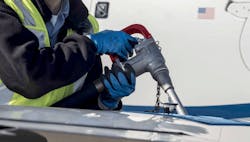NATA Updates Misfueling Training to Include Unleaded Avgas
The National Air Transportation Association (NATA) at the start of this year updated its Safety 1st General Aviation Misfueling Prevention Program to include new misfueling risks associated with unleaded avgas.
The training is available as a free online course and also is a required course for NATA’s Safety 1st Over-wing Refueling and Single-Point Refueling ratings, which require Misfueling Prevention and Diesel Exhaust Fluid (DEF) Contamination Prevention to be taken annually.
Safety 1st Ratings are a way to recognize that the knowledge and skills to safely perform specific aviation ground handling tasks have been achieved.
Last year, the Federal Aviation Administration (FAA) and other industry stakeholders announced the Eliminate Aviation Gasoline Lead Emissions (EAGLE) initiative, which outlines how the country can safely eliminate the use of leaded aviation fuel by the end of 2030. As more unleaded avgas makes its way to airports, the need for awareness related to unleaded misfueling prevention becomes greater.
Go to any gas station in the United States and there are at least three grades of gasoline. Steve Berry, NATA managing director of safety and training, says some might think it wouldn’t be difficult to add a third aviation fuel, in this case unleaded avgas.
However, Berry says the stakes are much higher in aviation.
“You can’t just pull off to the side of the road if the wrong fuel was used,” says Berry, who has been in the industry more than 20 years.
If the wrong type or grade is used to fuel an aircraft, he says, there is usually enough “good fuel” to get a plane off the ground before the pilot realizes there is a problem.
If, for instance, an aircraft that requires 100LL is fueled with UL94, Berry says the aircraft engine would probably continue to run but not at a power setting that would allow for continued flight. Unless the pilot can act quickly and turn the plane around immediately, the consequences can be catastrophic.
The additional risk imposed by the addition of another grade of fuel is compounded by not having a grade selective nozzle spout for UL94, like there is for avgas and Jet A fuel. Avgas 100LL and UL94 avgas nozzle spouts and filler ports are the same: small and round. Jet A spouts are wide and designed to not fit into avgas fuel ports, and like Jet A spouts, Jet A ports are wide. And while Jet fuel nozzles have a black handle, both avgas 100LL and UL94 have a red handle.
“Use extreme caution when dispensing unleaded avgas,” NATA’s misfueling prevention training emphasizes.
Currently Swift Fuels’ UL94 is the only grade of unleaded avgas that’s commercially produced and it’s only available at some airports. In the past few months the company expanded its UL94 avgas supply chain network. Swift Fuels works with fuel distributors / suppliers including World Fuel, Avfuel, Titan, Epic, P66 and others, and Swift Fuels CEO Chris D’Acosta says the company plans to expand with additional operating sites in strategic locations. UL94 is a 94+ Motor Octane aviation gasoline without tetraethyllead that meets the ASTM D7547 Unleaded Avgas specification. It’s FAA-approved for use in approximately 70 percent of the spark ignition piston fleet. That 70 percent of the spark ignition piston fleet burns about 30 percent of the volume, so it’s a bit of an inverse relationship, Berry says, which means there are high-performance aircraft that cannot use UL94.
Misfueling Missteps
When it comes to the missteps that lead to misfueling, Berry says nothing has really changed.
“It’s all about good communication, having a proper fuel order and confirming the grade with each refueling. We wanted to make sure that we kept that message that the basic principles of misfueling prevention haven’t changed. It’s just that now we have an additional risk.”
Misfueling itself is not new.
“It’s been a known risk for a long time,” Berry says, adding NATA has been working to educate as many people as possible about misfueling.
“If you are putting fuel into airplanes or have been putting fuel into airplanes, misfueling prevention should have already been a part of your training program,” he continues. “And now we’re just trying to keep it updated to reflect the current reality of the market.”
Since the Safety 1st General Aviation Misfueling Prevention Program was introduced in early 2016, more than 13,000 people have gone through the training developed to conform with Energy Institute (EI) standards.
“I think is a testament to people’s interest in this. They realize that it’s something that’s very real and lives have been lost because of misfueling,” Berry adds.
It’s difficult to quantify what mistakes didn’t happen, but Berry notes that 13,000 people understanding the dangers of misfueling has likely had an impact on the industry.
“I do like to think we’ve made a difference and that we’ve prevented a misfueling somewhere,” he says.
“We take pride in the training that we have and in making sure that aircraft are fueled safely,” Berry adds.
In fact, Berry says he wishes that 100 percent of the people who touch an aviation fuel hose would take the training. That includes pilots, line service techs and even passengers who might be asked to help fuel an aircraft.
“If you’re putting fuel into airplanes or if you’re involved in aviation, if you’re even tangentially involved, the training is free. It takes maybe 20-25 minutes to get through the training. And I think the knowledge you take away from it, about how critical it is, I like to think it will resonate with people and leave an impact because people die because of misfueling and it’s 100 percent preventable. It’s absolutely preventable,” he says. “Nobody sets out to misfuel an airplane, but mistakes happen. And they can be prevented with proper training and just remembering what you’ve learned and putting it into action.”
NATA misfueling prevention training will continue to evolve as updates are made in the industry. For instance, Berry says updates can be expected when the Energy Institute has a color code for unleaded avgas; if there is a new grade selective nozzle; and when there is a fleetwide drop-in replacement 100 octane fuel.
“We’ll keep up with the industry, try to stay ahead of them as much as we can,” he says. “When it comes to formalized training, we have to wait for the standards to be produced.”
In general, misfueling prevention is not difficult, according to Berry. It comes down to good communication between the pilot and the refueling operator, he explains.
According to NATA, key elements to misfueling prevention include complete fuel orders; selective nozzle spouts; and type and grade verification.
“Every fuel order, whether it’s verbal or written, needs to have the aircraft registration (tail) number, the volume of fuel, the type and grade of fuel, and then the refueler just needs to confirm that the placards at the fuel filler port match the placards on the equipment you’re dispensing from.”
Berry also calls out the work of Keith Clark, senior quality control and technical rep at Phillips 66 and the Save a Life - Verify Fuel Type campaign, which encourages communication between pilots and the FBO.
“It’s that simple,” Berry says. “You can literally save lives by verifying the fuel type before you fuel an aircraft.”
To further safeguard against misfueling, a pilot that requests UL94 needs to have a supplemental type certificate (STC) for engine and airframe.
“That’s not the responsibility of the line tech to know that really,” Berry says. “It’s up to the pilot to communicate the fuel they want. But it is important that the pilot have those placards (showing fuel type) installed on the filler port. That’s part of the STC process.”
According to Berry, common mistakes that lead to misfueling include a lack of communication, distraction and complacency.
“Really it comes down to human factors,” he says.
While misfuelings can occur, he says it’s important to know humans get it right most of the time. But he says 100 percent of misfuelings are preventable and the consequences are unforgiving.
“Refueling is a serious job,” he says. “We take it for granted because we do it so often. If you fuel 10 airplanes a day, you’re fueling thousands of airplanes over the course of your life. For the average line service tech, maybe tens of thousands, and we get it right nearly every time. But lives have been lost because of a simple preventable mistake. Safe a life. Verify fuel type. Get it right every time. You don’t have a choice.”
Misfueling Prevention Program
The NATA Safety 1st General Aviation Misfueling Prevention Program – along with videos, alerts, fact sheets, templates, operational best practices, and other valuable resources — are available at www.preventmisfueling.com
Course Objectives
- Understand aircraft misfuelings and their consequences.
- Learn the key elements to misfueling prevention.
- Be introduced to the misfueling risks posed by unleaded avgas.
About the Author
Rebecca Kanable
Assistant Editor
Rebecca Kanable, a veteran journalist, worked with Endeavor Business Media's aviation group from 2021 to 2024 as assistant editor of Airport Business, AMT and Ground Support Worldwide. She previously worked for various publications, including trade magazines and newspapers.

